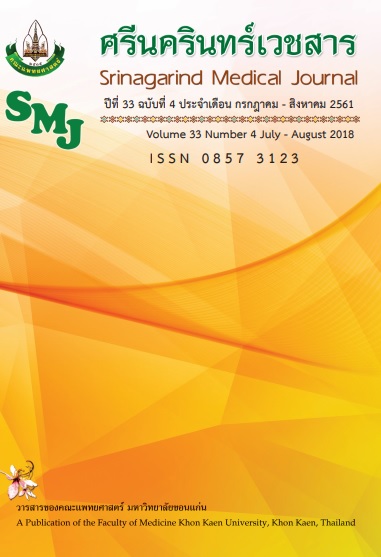Immediate Effects of Rhythmic Auditory Stimulation on Gait Speed, Stride Length, Cadence and Balance in Healthy Elderly
Keywords:
การทรงตัวในผู้สูงอายุAbstract
Background and Objective: Falling in the elderly is one of the major health problems affecting their daily life including walking. The declines in gait speed and stride length with aging could contribute to an increased risk for falling. This study aimed to determine the effects of the rhythmic auditory stimulation (RAS) at different frequencies on gait speed, stride length, cadence, and balance in healthy elderly.
Methods: Thirty-six healthy female elderly were recruited in this study. Ten-meter distance was used in all participants under four walking conditions (subject’s preferred walking speed, RAS+10%, RAS+20% and RAS+30%). Timed up and go test was assessed in all participants after each walking condition.
Results: The gait speed, cadence and balance performance of RAS+10%, RAS+20% and RAS+30% walking were significantly higher compared with subject’s preferred walking speed condition (p<0.05). The stride length of RAS+20% and RAS+30% walking increased significantly compared with subject’s preferred walking speed condition (p<0.05).
Conclusion: Higher frequency of RAS than normal subject’s walking speed could improve gait speed, stride length, cadence and balance in elderly. The findings of this study might give a further insight into application of RAS as an intervention to improve walking ability in elderly.
References
2. นันทศักดิ์ธรรมานวัตร์,กฤษณาตรียมณีรัตน์. เมื่อย่างเข้าสู่การเป็นผู้สูงอายุ. Available from: http://www.thaicam.go.th/index.php?option=com_attachments&task=download&id=270
3. วิชัยเอกพลากร. การหกล้มในผู้สูงอายุ: รายงานการสำรวจสุขภาพประชาชนไทยโดยการตรวจร่างกายครั้งที่ 4 พ.ศ.2551-2. สำนักงานสำรวจสุขภาพประชาชนไทย สถาบันวิจัยระบบสาธารณสุข. [Cited May 14, 2017] Available from:http://www.hisro.or.th/main/?name=knowledge&file=readknowledge&id=29
4. Peel NM, Kuys SS, Klein K. Gait speed as a measure in geriatric assessment in clinical settings: Asystematic review. J Gerontol A Biol Sci Med Sci 2013; 68: 39-46.
5. Fritz S, Lusardi M. White paper: "Walking speed: the sixth vital sign". J Geriatr Phys Ther 2009; 32: 2-5.
6. Roerdink M, Bank PJ, Peper CL, Beek PJ. Walking to the beat of different drums: practical implications for the use of acoustic rhythms in gait rehabilitation. Gait Posture 2011; 33: 690-4.
7. Thaut MH, Abiru M. Rhythmic auditory stimulation in rehabilitation of movement disorders: A review of current research. Music Percept 2010; 27: 263-9.
8. Ungermann CM, Gras LZ. Therapeutic riding followed by rhythmic auditory stimulation to improve balance and gait in a subject with orthopedic pathologies. J Altern Complement Med 2011; 17: 1191-5.
9. Eikema DJ, Forrester LW, Whitall J. Manipulating the stride length/stride velocity relationship of walking using a treadmill and rhythmic auditory cueing in non-disabled older individuals. A short-term feasibility study. Gait Posture 2014; 40: 712-4.
10. YuL, Zhang Q, Hu C, Huang Q, Ye M, Li D. Effects of different frequencies of rhythmic auditory cueing on the stride length, cadence, and gait speed in healthy young females. J Phys Ther Sci 2015; 27: 485-7.
11. Train The Brain Forum Committee. Thai mental state examination (TMSE). Siriraj Hosp Gaz 1993; 45: 359-74.
12. Cha Y, Kim Y, Chung Y. Immediate effects of rhythmic auditory stimulation with tempo changes on gait in stroke patients. J Phys Ther Sci 2014; 26: 479-82.
13. Rizzo JR, Raghavan P, McCrery JR, Oh-Park M, Verghese J. Effects of emotionally charged auditory stimulation on gait performance in the elderly: A preliminary study. Arch Phys Med Rehabil 2015; 96: 690-6.
14. Suh JH, Han SJ, Jeon SY, Kim HJ, Lee JE, Yoon TS et al. Effect of rhythmic auditory stimulation on gait and balance in hemiplegic stroke patients. NeuroRehabilitation 2014; 34: 193-9.
15. Schaefer RS. Auditory rhythmic cueing in movement rehabilitation: findings and possible mechanisms. Philos Trans R Soc Lond B Biol Sci 2014; 369(1658): 20130402.
16. Juntunen J, Matikainen E, Ylikoski J, Ylikoski M, Ojala M, Vaheri E. Postural body sway and exposure to high-energy impulse noise. Lancet 1987; 2(8553): 261-4.
17. Chen JL, Zatorre RJ, Penhune VB. Interactions between auditory and dorsal premotor cortex during synchronization to musical rhythms. Neuroimage 2006; 32: 1771-81.
18. Menon V, Levitin DJ. The rewards of music listening: response and physiological connectivity of the mesolimbic system. Neuroimage 2005; 28: 175-84.
19. Thompson WF, Schellenberg EG, Husain G. Arousal, mood, and the Mozart effect. Psychol Sci 2001; 12: 248-51.




